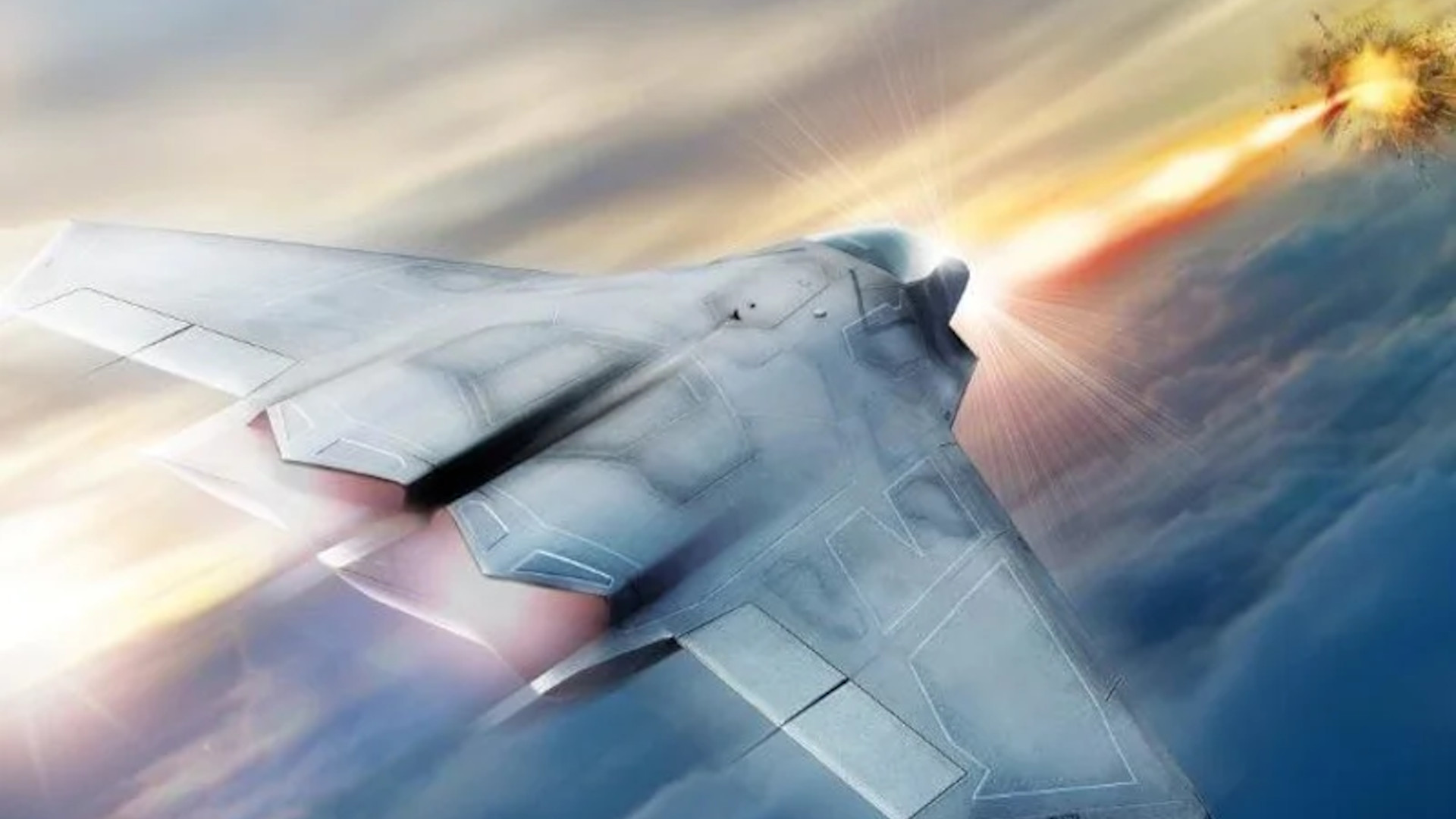Newly declassified U.S. Air Force documents underscore that the service views laser directed energy weapons, for use on combat jets in defensive and offensive roles, as a core capability within its broader Next Generation Air Dominance program, or NGAD. They also highlight past work to understand potential countermeasures to these weapons and to better integrate them into air-to-air combat simulations and modeling. This is all additionally notable given various U.S. military efforts ongoing today that appear to be tied to, at least in part, the employment of lasers in future air combat, which The War Zone has been following closely.
The new insights into the Air Force’s interest in laser weapons in relation to the NGAD program come from partially redacted portions of an internal Air Combat Command (ACC) history covering the period between October 2014 and September 2016, which The War Zone obtained via the Freedom of Information Act (FOIA). The NGAD program, as it exists today, traces its immediate origins to projects the Air Force conducted in cooperation with the Defense Advanced Research Projects Agency (DARPA) in the 2014-2015 timeframe, particularly the Aerospace Innovation Initiative.
NGAD is an overarching future aerial combat initiative that includes work on a crewed stealth combat jet and various uncrewed platforms, as well as new weapons, sensors, engines, and networking and battle management capabilities, among other things. The expectation is that all of these developments will eventually form a collaborative whole.
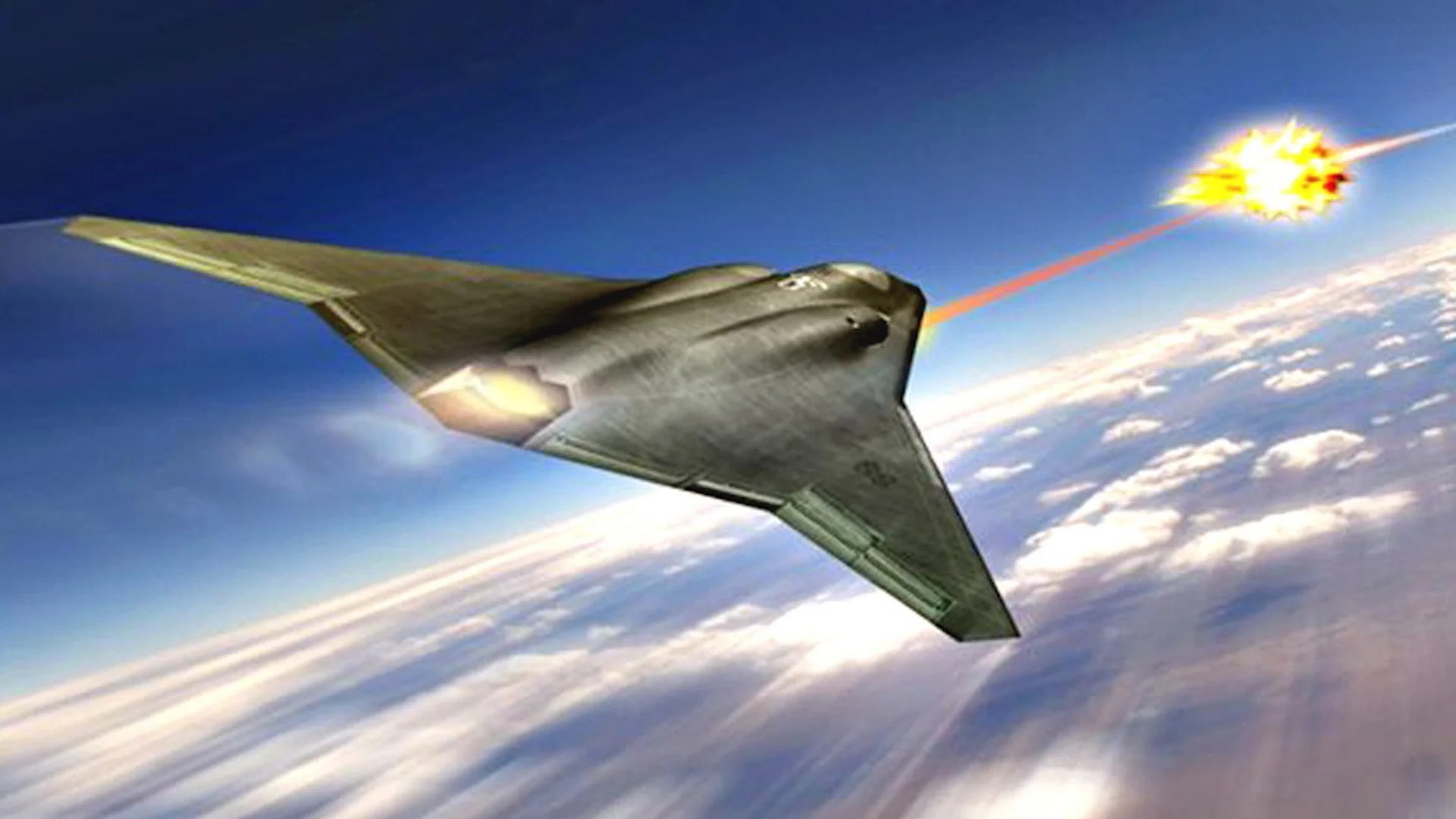
“Though ACC possessed no actual funded Programs of Record in the technological milieu (or for that matter, had a documented Official Requirement for any), 2015-2016 saw rapidly increasing interest in and oversite of new weapons based on the science of Directed Energy (DE),” the 2014-2016 ACC history explains. “The potential lethality of all DE weapons under development through [U.S. government] labs and industry in FY15-16 [Fiscal Year 2015-2016] ran the full gamut from devices designed to defeat threats merely by breaking communication locks and/or blinding guidance systems, all the way to total destruction of the respective hostile assets.”
It is worth noting that directed energy weapons including high-powered microwaves, among other things, as well as lasers, but the unredacted portions of the ACC history focus primarily on laser weapons, and the Self-Protect High Energy Laser Demonstrator (SHiELD) program specifically. SHiELD, which is an Air Force Research Laboratory (AFRL) led Advanced Technology Demonstration (ATD) program, traces its roots back to 2013.
The project’s main objective so far has been the development of a podded laser directed energy weapon primarily intended to destroy incoming missiles, but AFRL has noted the potential for the system, or a variant or derivative thereof, to have offensive capabilities for years now. Self-defense and possibly broader within-visual-range close combat are likely to be the first practical use cases for airborne laser weapons, though their capabilities could certainly expand over time.
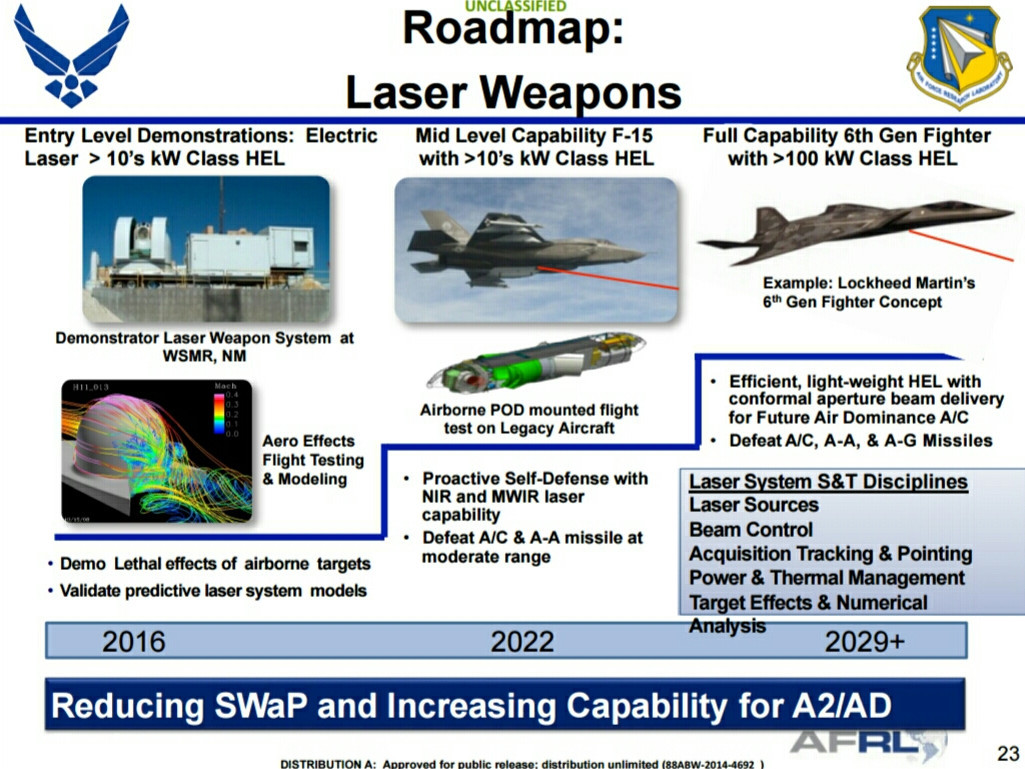
The newly declassified ACC history refers to two key drivers behind the SHiELD program, but details about the first of these are entirely redacted.
“The second driver leading to SHiELD came in the form of a series of meetings between key leadership of AFRL and ACC throughout 2014 and 2015. The first occurred in 2014. Lt Col [Redacted] and Doctor Janet Fender, the ACC Chief Scientist, traveled to Kirtland AFB [Air Force Base] and directly approached lower-level project officers,” the internal historical record says. “There they discussed the initial unpublished results of the HEL-FAD study, communicated ACC’s desires with regards to LWSs [laser weapon systems], and essentially asked for any valid reasons detailing why they could not [emphasis from the original document] be met.”
HEL-FAD is the abbreviation for a study that was formally titled High Energy Laser (HEL) Weapons for Protection of the Future Air Dominance Fighter. Footnotes in the 2014-2016 ACC history say a second draft was completed in 2015, but it’s unclear if a final draft was ever officially completed.
“After some initial skepticism on feasibility from the AFRL ‘worker bees’ involved, the lab came on board and began aggressively pursuing initial concept solutions,” the history adds.
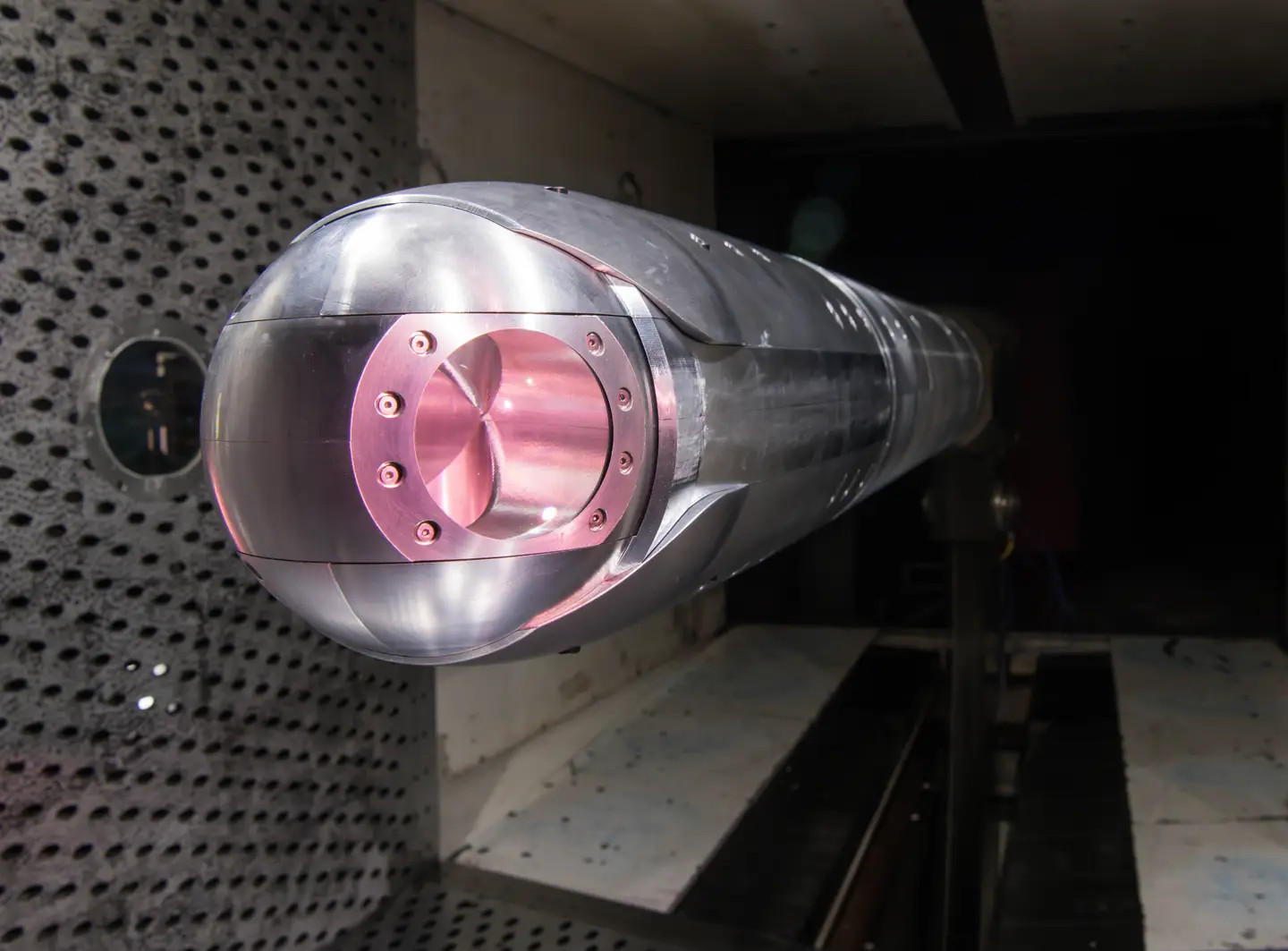
“The coordination process… (and SHiELD itself) were significant both because it represented the first time that so much money (at least 300-500 million dollars…none of which ACC funded) since ABL [Airborne Laser] had been allocated for a particular DE project, and because the relation between AFRL and the MAJCOMS [Major Commands] had traditionally worked in the reverse [emphasis in the original] direction,” it continues. “In the case of SHiELD, it was CC who went to the lab and specifically requested a rather detailed proposal for a specific ATD.”
Airborne Laser, later renamed the Airborne Laser Testbed, was a ballistic missile defense-oriented test program during the late 1990s and 2000s, which centered on a heavily modified Boeing 747 airliner armed with a very large chemical laser. The core concept behind the aircraft, which was designed the YAL-1A, was to offer a way to shoot down enemy ballistic missiles in the initial boost phase, as you can read more about here. The program was finally canceled in 2011 amid growing costs and questions about its practicality, and the aircraft was scrapped entirely in 2014.

Since then, there have been huge advances with regard to more compact solid-state lasers, such as the one Lockheed Martin has developed for SHiELD, as well as other key related technologies, such as systems for beam control and direction, thermal handling, and power sources. You can learn more about how Lockheed Martin, in particular, has been working to move practical aerial laser weapons from the realm of science fiction into reality in this past War Zone feature.
So far, AFRL’s plan for the SHiELD pod, at least initially, remains to test it first on legacy combat jets, such as the F-15 and F-16. However, the internal history makes clear that ACC had significant interest, at least in the 2014-2016 timeframe, specifically in the development of a laser directed energy weapon for integration on a future sixth-generation combat jet. We don’t know what other airborne laser directed energy weapon programs may have been running in parallel to SHiELD, then or now, especially in the classified realm, too.

“ACC stated the ATD would inform the Analysis of Alternatives (AoA) for the next-generation fighter aircraft (Future Air Dominance Fighter) scheduled for 2017,” according to the history. In addition, “in order to meet ACC’s 2023 timeline to inform decisions on the Next Generation Air Dominance development strategy, AFRL stated it would be necessary to complete all three phases [of the ATD], demonstrating a full Laser Weapon System (LWS) capability at a Technology Readiness Level (TRL) 6.”
The unredacted portions of the 2014-2016 internal history also include some observations and conclusions, as well as recommendations, taken from the classified draft HEL-FAD study. This provides additional insight into the Air Force’s laser directed energy weapon plans.
“The effectiveness of DE, KE [kinetic energy], and LO (low observable) capabilities to provide air superiority for 6th generation aircraft was assessed,” according to one partially redacted table from the history. “Evaluations were done of the mission potential and technical feasibility of an HEL system on-board a future multi-role high performance platform such as the F-X [Future Air Dominance Fighter].”
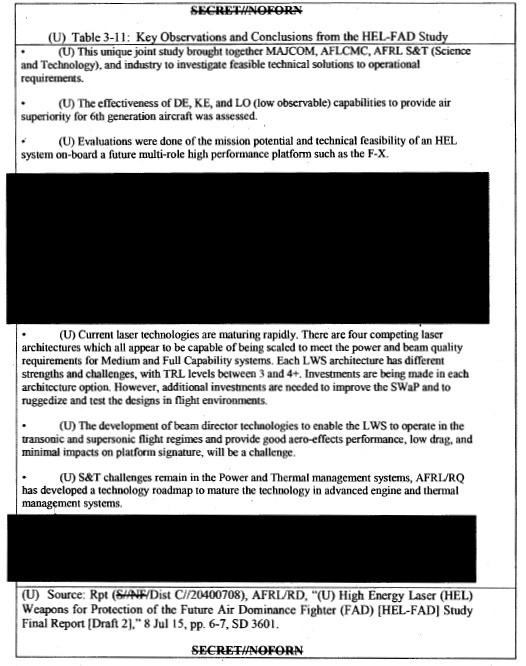
“Continue the vulnerability assessment and laser effects work to explore a broader set of targets and alternate aim points on those targets. Perform an assessment of potential enemy counter-measures to the laser or its pointing and tracking system,” was one of the draft study’s recommendations. “Continue to develop and integrate HEL engagement models into BRAWLER to ensure HEL engagement enhancements are in place for the 2030+ Air Dominance AoA.”
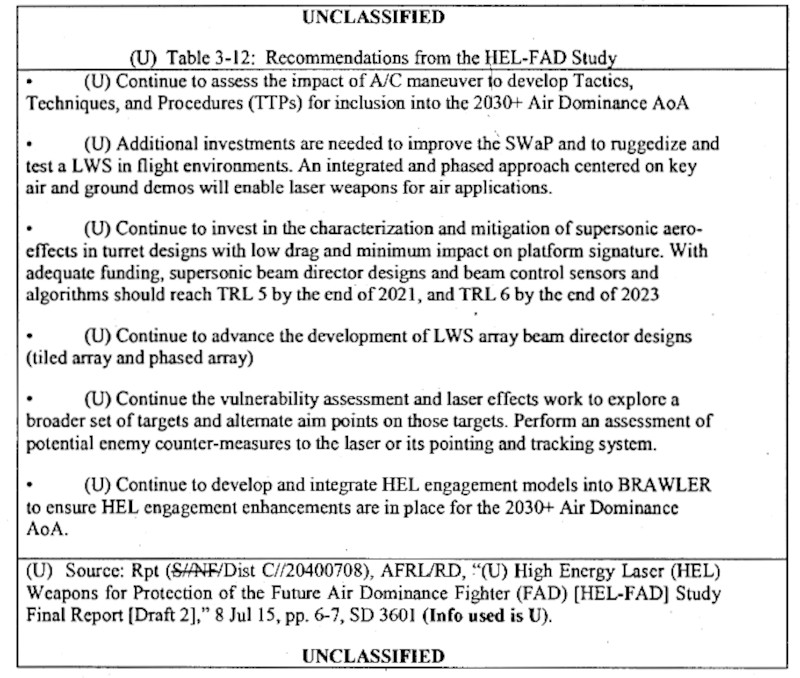
It’s not perfectly clear what “BRAWLER” here refers to, but the Air Force-Navy-Army tri-service Joint Aircraft Survivability Program (JASP) does have an air-to-air combat simulation tool with that name. It would make good sense that those parties would all be interested in integrating high-energy laser directed energy weapons both as friendly capabilities and as potential threats in aerial combat simulations and other kinds of modeling.
How long it may be before we actually see a sixth-generation crewed combat jet, whether it be in a pod or directly integrated into the airframe, remains to be seen. As The War Zone has noted on multiple occasions, it is very unlikely that the crewed combat aircraft currently being developed under NGAD will look or perform like a traditional fighter jet, to begin with. A self-contained podded laser directed energy weapon system could find its way onto other platforms, crewed and uncrewed, as well.

The Air Force is continuing to pursue SHiELD as an ATD program, but it has suffered technical and other delays, and flight testing of the first examples of the complete system is now not expected to begin at least until 2023. The Air Force is separately developing a laser directed energy weapon for integration onto the AC-130J Ghostrider gunship, but this is a substantially larger system that would not be suitable for a fighter-sized combat jet.
The Air Force, Navy, and Army are all actively developing a number of other directed energy weapons, including laser and high-powered microwave designs, for ground-based and naval applications. The Navy has already begun to field multiple types of directed energy weapon systems onboard different types of warships, some of which are powerful enough to shoot down hostile drones.

In recent years, stealthy Air Force F-22 Raptor and F-117 Nighthawk combat jets, along with Navy F-35C Joint Strike Fighters, all assigned to test and evaluation units, have also emerged covered in unusual mirror-like coatings. Though the exact purpose or purposes of these metallic-looking finishes are unknown, they may be related to work on laser weapons or countermeasures to laser-based systems, among other things, as The War Zone has explored in detail.
Mirrored finishes and other features linked to laser-related work have appeared on Northrop Grumman subsidiary Scaled Composites’ stealthy Model 401 “Son of Ares” test jets, in recent years, too. One of these two aircraft just recently emerged with new artwork on a ventral pod, the exact purpose of which remains unexplained, that indicates a direct connection to an airborne laser project.
All of this would seem well in line with the recommendations to continue work related to laser countermeasures and counter-countermeasures, as well as to simply continue exploring how laser directed energy weapons might be employed in aerial combat, that we now know were contained in the 2015 draft HEL-FAD study.
No matter what, the portions of ACC’s internal 2014-2016 that the Air Force has now released make clear that the service sees laser directed energy weapons on future advanced stealthy combat aircraft, and possibly other platforms, as a key component of its future NGAD ecosystem.
Contact the author: joe@thedrive.com
